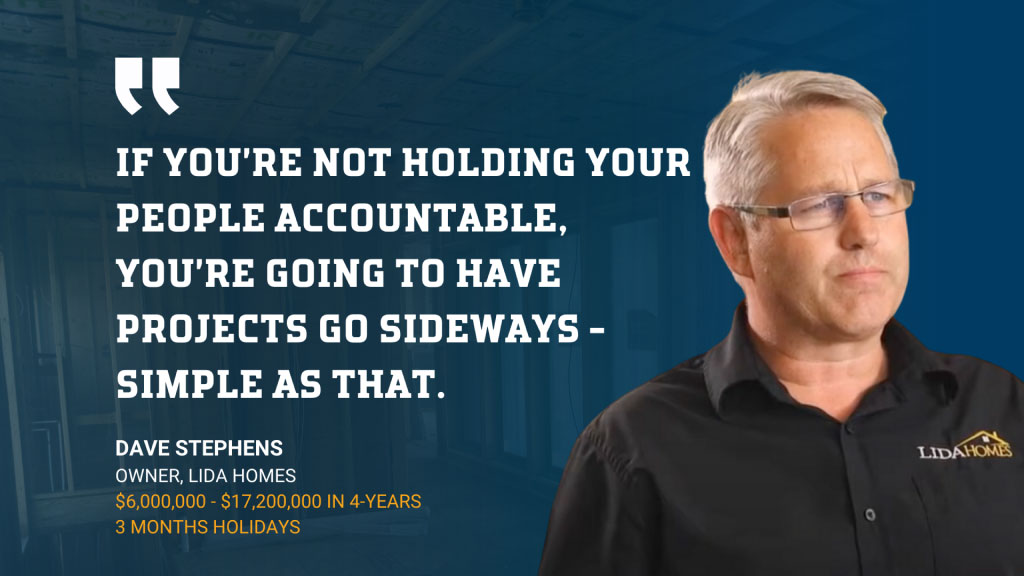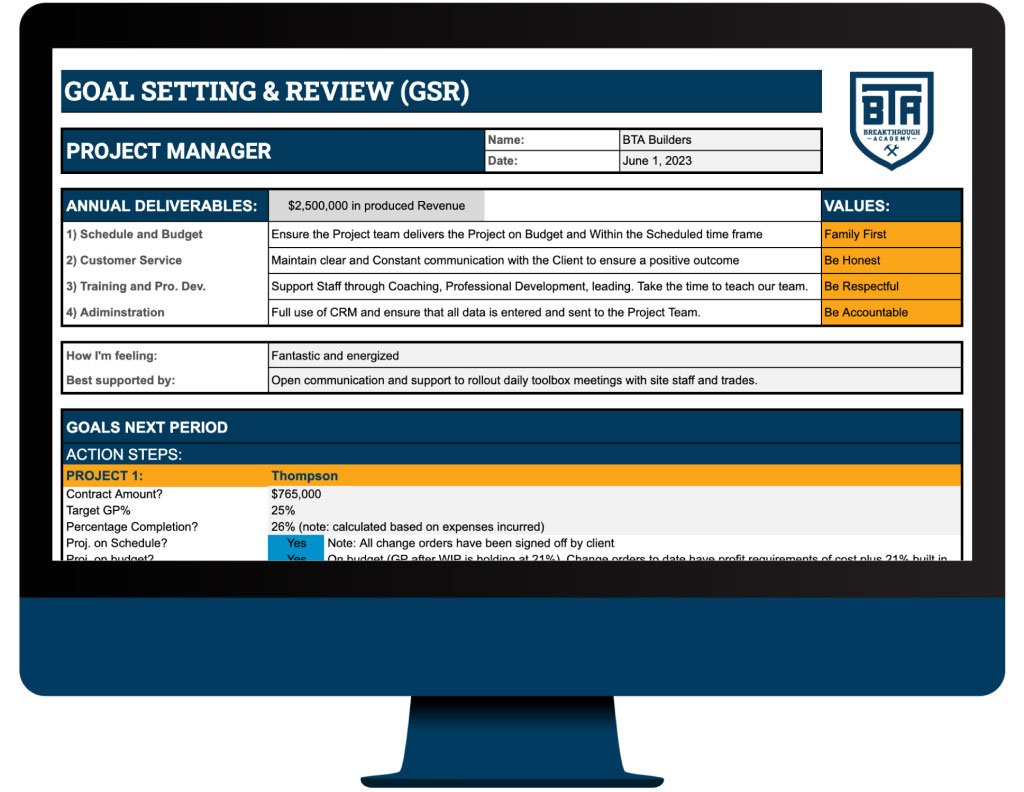Being a contractor is not for the faint of heart. It’s natural to look at business challenges and blame the usual suspects: a terrible labor market and all-too-common supply issues.
But there is one overlooked reason why contractors run into project delays, company drama, and poor profit… a lack of staff accountability.
If you tell your staff to turn right and watch as they swerve left, you have an accountability issue on your hands.
*Sad trombone*
But there is good news. Unlike supply and labor shortages (which are largely out of your control) — staff accountability is an area of your business that you can take full ownership over.
And it’s surprisingly easy to fix.
In this article, we’ll show you why poor accountability is so rampant in our industry and how to identify if you have a staff accountability problem.
Then we’ll show you exactly how to improve staff accountability within your company with a simple method that has been proven to work by over 1,500 leading contractors across the US and Canada.
Let’s dive in.
- How LIDA Homes grew from $6MM to $17MM in 4 years
- Watch our on-demand web class: Scaling to $10MM & Beyond: Staff Accountability Secrets of Rapid-Growth Contractors
Why is poor accountability so rampant in construction & trades?
Real talk: it’s hard to confront your staff when you’re nervous about losing them.
Construction and trades have one of the highest turnover rates in the United States, coming in at a whopping 65%.
While this number isn’t specific to employees leaving due to confrontation, it influences our industry’s lack of accountability. There is immense pressure for contractors to be likable amongst their staff (so they don’t quit).
Five warning signs you’ve got an accountability issue
For a construction project to be successful, a lot of mechanisms need to function in harmony. When they don’t, the reason can often be found in your approach to accountability.
So, what is accountability, exactly? It’s everyone doing what they say they’ll do and taking responsibility for their jobs. Okay, great. But what does that look like, day to day?
To paint that picture, it’s worth looking at what accountability isn’t. If any of the below feel familiar… you’ve probably got a problem within your organization.
1. Meaningless goals
You’ve set some standards. Maybe you even have a few processes in place. But try as you might, you can’t get your team to follow them. It’s like trying to lead a herd of buffalo to an open bar. For some curious, bewildering reason, they just. won’t. Go.
⚠️ Can every member of your team show you the top priorities they have committed to (in writing)?
2. Blame games
When things go wrong, nobody steps up to own the problem. Instead, there’s a lot of finger-pointing and buck-passing. “Wasn’t me” feels like the team mantra.
⚠️ Do your employees take ownership of mistakes — or pass the buck?
3. Rogue actions
You asked for shrubs to be moved. They built you a birdhouse. Alright, maybe that’s an elaborate example, but you get the idea. You ask for one thing, and what you get is something completely different.
⚠️ Do your staff follow directions and company processes — or do things their way?
4. Entitled mindsets
Not to be mistaken for ambition (which is a good thing), with entitlement, you’re getting requests for raises, promotions or other demands that haven’t been earned.
⚠️ Do your staff request raises, bonuses, and time off that they have not earned?
5. Stagnant business
Your company seems like it’s plateaued. You may still be busy, but it feels like you’re stuck in a rut, and your team is just going through the motions.
⚠️ Do you have a reliable team that drives your business growth forward — or have you hit a stand still?
You can’t manage what you can’t measure.
Why instilling accountability is daunting
Many contractors feel overwhelmed by the thought of making accountability a more entrenched part of their operations.
It’s not uncommon to get distracted by worries such as:
- Feeling like you have to crack the whip… and then nobody will like you.
- Getting stuck having to do a bunch of handholding you just don’t have time for.
- Losing people. It’s already so difficult to find staff, you can’t afford to give up the ones you have, right? (Trust us when we say, you definitely can.)
But the real underlying reason you’re struggling to instill accountability? We’re going to get real for a second and hit you with a hard truth. You ready?
It’s you.
Accountability rests with you. You’re the leader. If staff feel distanced from your company’s vision, your expectations aren’t clear. And it’s your job to fix it. (We did say this would be simple… not necessarily easy.)
Time to step up.
Get from goal to result without losing your way
The good news is, becoming an organization that embraces – rather than shuns – accountability doesn’t have to be painful. You just need a good system. Goal Setting & Review (GSR) is a leadership tool that bridges the gap between where you are and where you want to be.
It provides a framework for accountability within your company and helps define precise action items for nailing goals, while giving you visibility into the state of the projects you do for clients as well as the implementation initiatives you undertake internally. Because you can’t manage what you can’t measure.
We’ve seen companies achieve exceptional growth after instituting a GSR system. If you’re curious to learn more, we’ve got an on-demand web class that covers the secrets behind using a GSR system to better support your team.
Do what you said you would? Get rewarded.
Don’t? Lose out. Straightforward as that.
Key components of a GSR system
The Goal Setting & Review system centers around regular, one-on-one meetings between you and your direct report, where you’ll look at their status in three timeframes: past, present and future – what they’ve done, how they’re doing now, and what they intend to do next.
There’s a lot of flexibility when setting up a GSR for your individual business. Regardless of how you use it, there are some key aspects that shouldn’t change:
- Consistency: The meeting schedule should be set in stone. Whether it’s weekly, or bi-weekly, it should occur at the same time, every time.
- Preparation: To make the meeting productive, your direct report should show up with their plan ready and all metrics completed, which forces them to be dialed in to what’s happening in their world.
- Specificity: “Do my best” doesn’t cut it here. Each goal for the week should be crystal clear so you can see right away whether it’s completed or not. Evaluating success should be black or white. No gray zones here.
- Focus: This plays out in a couple ways, on both sides of the table (or screen, if you meet virtually). To avoid overwhelming your direct, have them aim to achieve just one or two high priority goals at a time. In return, during the GSR meetings, give them your full, undivided attention.
To learn the GSR process and how to actually get your team following it, watch our FREE on-demand web class, Scaling to $10MM & Beyond: Staff Accountability Secrets for Rapid Growth Contractors, now.

How LIDA homes grew from $6MM to $17MM in 4 years
Lida Homes, owned by Dave Stephens, is a high-end custom home builder that has become renowned on Vancouver Island for their award-winning customer satisfaction. They also more than doubled their revenue in the break-neck span of four years.
For Dave, the GSR system was a game-changer. Prior to using it, he described accountability at his business as very hit or miss. With GSR in place, everyone had a better understanding of their roles and projects met the exceptional standards customers had come to expect.
Dave holds weekly GSR Meetings with his top managers and executive members to ensure their company and projects are on track.
As part of his set-up, Dave also created a points system that tied his team’s adherence to a performance bonus. Do what you said you would? Get rewarded. Don’t? Lose out. Straightforward as that.

What does a GSR meeting look like?
Your GSR system should be molded to fit the particular needs of your organization. Here’s an example of what you might cover in an effective GSR meeting with a project manager tasked with producing $1.5MM in revenue for the year.
Obviously, that’s a massive goal, so you’d want to break it down into chunks for what needs to happen each week. Then in the meeting, you’d go through each project and look at elements such as:
- Is the project on schedule?
- Is it on budget?
- Are the labor hours on track?
- Where’s the percent completion sitting?
- Is the material procurement under control?
- Has the client update been sent out?
- Do we foresee any possible issues? If so, how can we get in front of them?
There’s another vital question you want to be sure to include: How are you doing?

Why is this the most important question in the entire meeting? Beyond just helping to keep projects on track, GSR systems are about ensuring your staff knows they’re supported and you’re looking out for them.
Developing your relationship with your direct is pivotal. This system isn’t just about them working to achieve your goals for your company. It’s also about you supporting them to achieve their goals to develop their career. For example, most Production Managers are under-supported firefighters, overworked and frustrated. A little love goes a long way.
How to handle sticky situations
To help you out, we’ve put together a GSR template you can use for your own meetings, which you can get for FREE in this on-demand web class.
In an ideal world, you’d implement a GSR system, everybody loves it, immediately jumps onboard, and you’d start getting the absolute best from your team the next day.
In reality… things may not be that clear cut. There might be a direct report who struggles to meet the standards. In some cases, they’ll recognize the new way of working just isn’t for them, and they’ll bow out on their own.
But if they’re determined to stick it out, the onus falls on you to figure out what support they require to unlock their full potential. Best case scenario, they discover a whole new range of capability within themselves, and they ultimately thank you for it. Worst case, no matter what you do, their performance doesn’t improve, and you have to make a tough call.
Fortunately, we’ve got you covered with a guide to navigating thorny conversations, FREE as part of this on-demand web class.
Prepare for your business to transform
In our experience, employees generally respond very well to the newfound support and empowerment they receive through a GSR system. High performers want to have clear goals and deliverables.
While you’ll only be holding GSR meetings with your direct reports, the system can have a knock-on effect throughout the entire organization. Productivity becomes more efficient. Employee retention improves. Staff develop faster.

Measurable results help everyone stay on track, which means you spend less time firefighting. Your team goes from being reactive, to being proactive. Your profit margins improve. And your phone quits ringing at all hours of the day and night.
Start thinking about where to take your partner for dinner. Date nights can be a thing again.
Change your business, change the world
At first glance, it might seem that constructing a system around your goals is just about what happens inside your business. But look closer, and you’ll start to see a rippling impact that extends well beyond that. In a world that can sometimes feel overly accepting of mediocrity, it’s worth remembering that results matter. Not just to your business, or your customers, but also to your people.
By upholding higher standards, you’re inviting your team to take greater pride in their work and become better individuals within society. Their eyes will open to the realization that how they function influences those around them, on every level. Don’t underestimate the power of a small business to have a massive positive impact on the wider world. A little accountability can go a long way.
Ready to learn more about how a solid GSR system can take your business to the next level? Watch our FREE on-demand web class, Scaling to $10MM & Beyond: Staff Accountability Secrets for Rapid Growth Contractors, today.

Want to scale up, get off your job sites, and get out of sales?
Breakthrough Academy shows 7-figure contractors how to systemize their business for growth. Find out how we can help you scale up (with less stress)
